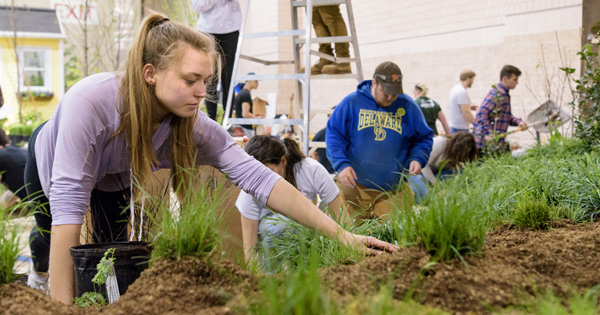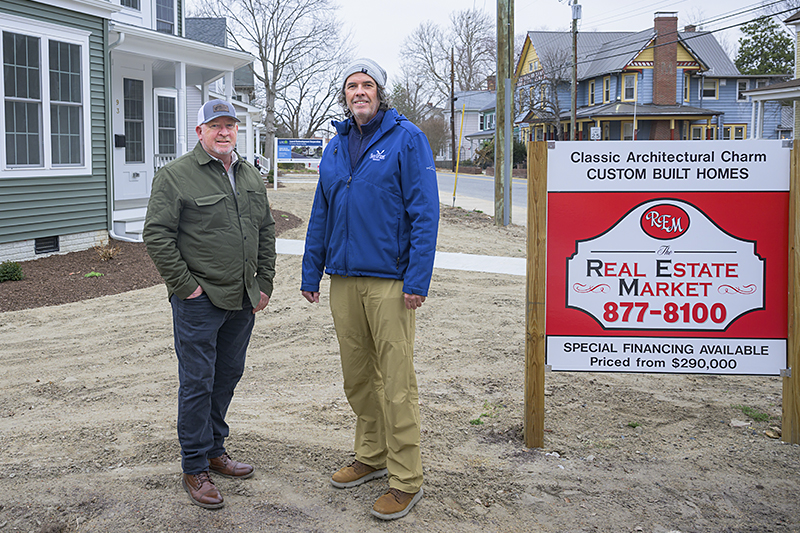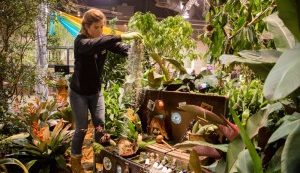
Bachelor of Landscape Architecture
The mission of the Bachelor of Landscape Architecture (BLA) is to prepare students to become innovative leaders in the design and planning of cultural and natural landscapes with expertise in plants and ecosystems. Through courses, community-based service-learning projects, internships, and global study abroad opportunities, students will develop diverse perspectives, critical thinking and creative problem-solving skills required of future leaders in the profession of landscape architecture. The accredited program will also prepare students for the professional licensing examination.
Key subject areas include plants and ecosystems; communications; site design and engineering; design, planning and management; public policy and regulations; computer applications; natural and cultural systems; sustainability; history, theory and criticism; professional practice; professional values and ethics; creative problem solving, art, business, math and science.
The University of Delaware has a great tradition of excellence, from our roots extending back to a small private academy started in 1743, to the research-intensive, technologically advanced institution of today.
Our alumni tell our story of achievement, from our first class, which included three signers of the Declaration of Independence and one signer of the U.S. Constitution, to the more than 200,000 living Blue Hens who are making vital contributions to the world. President Joseph R. Biden Jr. and First Lady Jill Biden are both UD alumni.
The University received its charter from the State of Delaware in 1833 and was designated one of the nation’s historic Land Grant colleges in 1867. Today, UD is a Land Grant, Sea Grant and Space Grant institution. The Carnegie Foundation for the Advancement of Teaching classifies UD as a research university with very high research activity-a designation accorded less than three percent of U.S. colleges and universities. UD ranks among the nation’s top 100 universities in federal R&D support for science and engineering.
A state-assisted, privately governed institution, UD offers a broad range of academic programs, including three associate degrees, 165 bachelor’s degrees, 135 master’s degrees and 64 doctoral degrees. Our student body encompasses more than 18,000 undergraduates, more than 4,500 graduate students and more than 800 students in professional and continuing studies from across the country and around the globe. Our distinguished faculty includes internationally known scholars and experts.
It is the preference of the BLA program that students use a PC system, as this is the platform used to teach introductory computer-aided design and is the platform required to run most of the software used in subsequent BLA courses. Learn about computer requirements for the BLA major.
Please email Dr. Eric Bardenhagen with any questions.
The goals of the UD BLA program are to graduate students who:
- Demonstrate knowledge, awareness, attitudes, skills, and opinions of key subject areas defined by the Landscape Architecture Accreditation Board (LAAB) and Landscape Architecture Body of Knowledge (LABOK);
- Are prepared to successfully engage in the community by participating in community-based service learning projects and internships;
- Solve problems correctly and creatively and develop critical thinking, collaboration, and communication skills (as defined by BLA Program Educational Goals and Learning Outcomes); and
- Are prepared to work in professional landscape architecture firms, or enter a graduate program, and are aware of the requirements needed to take the four-part state-based licensure examination.
The University of Delaware's Bachelor's of Landscape Architecture program is accredited.
In recognition of the impact of the landscape architecture profession on public health, safety, and welfare, states regulate landscape architectural practice through licensure. Founded in 1899, the American Society of Landscape Architects (ASLA) is the professional association for landscape architects in the United States, representing more than 15,000 members. Landscape architects lead the planning, design, and stewardship of healthy, equitable, safe, and resilient environments. The Society’s mission is to advance landscape architecture through advocacy, communication, education, and fellowship.
The Landscape Architectural Accreditation Board (LAAB) is vested with its authority by the ASLA Board of Trustees to develop and promulgate the accreditation standards, rules, and procedures for conducting the accreditation process. Accreditation is a non-governmental, voluntary system of self-regulation. Its core is the concept of self-evaluation. The LAAB accreditation process evaluates each program on the basis of its stated objectives and compliance to externally mandated minimum standards. The program conducts a self-study to evaluate how well it is meeting its educational goals. The LAAB then provides an independent assessment, which determines if a program meets accreditation requirements. Programs leading to first professional degrees at the bachelor’s or master’s levels in the United States are eligible to apply for accreditation from the LAAB.
The University of Delaware's Bachelor's of Landscape Architecture program is accredited and meets the educational requirements for licensure in all 50 states and the District of Columbia. Most states require 2-4 years of experience under a licensed landscape architect and successful completion of the Landscape Architecture Registration Examination. You can check ASLA's website for license requirements for each state (look up each state here).
Core BLA Faculty
Associate Professor of Landscape Architecture
Dr. Bardenhagen is an Associate Professor of Landscape Architecture who teaches "The Built Environment Studio," which is an introduction to principles involved in the design and installation of landscape elements: stone, brick, concrete, wood and metal.
Professor and Extension Specialist, Ornamental Horticulture
Dr. Barton investigates roadside vegetation management strategies that enhance the environment, are aesthetically pleasing, and economically sound. She promotes sustainable landscape practices through a variety of publications in the Plants for a Livable Delaware series, series of brochures that educates Delawareans on plants that will easily survive in Delaware’s climate, help build more healthy ecosystems, and not become invasive species.
Instructor of Landscape Architecture
Hammaker is a landscape designer working across landscape scales from residential to regional. He teaches foundational studios and digital representation. His design interests lie at the intersection of planning, landscape architecture, and the environment – finding holistic solutions to the complexities of large-scale contemporary issues of climate change, cultural identity, socioeconomic disparity, food systems, and environmental degradation, especially in the interstitial spaces between rural and urban communities.
An Atlas for the Green New Deal (nominated for the Cooper Hewitt National Design Award for Climate Action)
Associate Professor of Landscape Architecture
Anna Wik is a registered professional landscape architect in Delaware and Pennsylvania and an Associate Professor in the Department of Plant and Soil Sciences at the University of Delaware. She has designed, documented, and managed construction of many landscape projects in the Delaware Valley region, working with community and non-profit partners including Delaware State Parks, Delaware Historical and Cultural Affairs, Delaware Historical Society, Philadelphia Parks and Recreation, Philadelphia Water Department, the Lenape Indian Tribe of Delaware, and numerous community groups. Anna’s courses investigate the relationship between the cultural practice of design and the built environment. She is passionate about equitable design and is interested in historical, social and cultural influences upon the urban and rural landscape. Other research areas include children's outdoor learning environments, coastal resilience related to cultural landscapes, and edible forest gardens. Anna earned her Masters of Landscape Architecture from the Rhode Island School of Design.
Assistant Professor of Landscape Horticulture and Design
Prof. Zimmerman's research interests are positioned at the nexus of experiential learning and sustainable landscape construction and performance with the dissemination of these materials to communities in an accessible way.
Other contributing faculty
Professor of Plant Biology
Dr. Bais's rhizosphere biology research is focused on understanding the biological significance of root exudation. Root-root, root-microbe, and root-nematode communications are continuous occurrences in the rhizosphere, but due to the underground nature of roots, these intriguing interactions have largely been overlooked. His lab research is taking a multidisciplinary approach by interfacing plant biology and chemistry to unravel the underground communication process.
Chair and Professor, Turfgrass and Horticultural Systems
Physiology and ecology of turfgrass responses to abiotic stresses and the use of synthetic and natural plant growth regulators for improved stress response.
Adaptation (variety and germplasm evaluation) and cultural management (irrigation, fertility, mowing, cultivation) requirements of cool- and warm-season turfgrasses used on golf courses, lawns, parks, athletic fields, and roadsides.
Ecology and adaptation of native grasses and forbs for pollinator meadows in the mid-Atlantic.
Professor of Soil and Environmental Microbiology
Dr. Fuhrmann investigates the ecology and diversity of microbial populations in soil-plant systems, microbial community responses to environmental perturbations, effects of soil-borne viruses on microbial communities and rhizobia, and symbiotic nitrogen fixation.
John Bartram Associate Professor of Urban Forestry
Dr. Trammel is an urban ecologist whose lab studies how interactions with humans and the consequences of human society affect urban ecosystems’ structure and function. She investigates how collections of trees and plants that grow within cities respond to threats such as pollution and invasive species, and how these urban forests provide ecosystem services to the inhabitants of the city.
Students choose many different pathways and interest areas. The PLSC BLA allows students the flexibility to obtain a minor and further develop their skills in the interest areas of their choice. Many students find work doing what they love – whether that is designing and planning ways to make the environment more sustainable or researching ways to preserve or conserve historic landscapes – the career options for landscape architects are plentiful. Currently, BLA alumni: attended/are attending graduate school (e.g., the Penn/Delaware Graduate Fellowship); are in professional practice as landscape designers in landscape architectural practices; are working as landscape designers for design/build firms; and are working in government. To see the many interest areas of current practitioners, visit the ASLA Professional Practice Networks website.
The BLA program contributes to the community by engaging students in service learning projects. The program seeks to expose students to the most pressing issues of our times through relevant coursework, extracurricular activities, and participation in both local and national conferences.
As students engage in active learning in studio courses and complete a required internship, they develop their capacity to creatively and successfully solve problems while advancing critical thinking, collaboration, and communication skills.
We collaborate regularly with local, state, and regional partners on conceptual designs for projects ranging from urban design, to coastal resilience, to landscape management and master planning. If you are interested in interacting with our students in a visioning or conceptual design project, we would love to hear from you. If you are interested in a Landscape Design Community Partnership, please contact Anna Wik and fill out the questionnaire.
Every other year, in odd-numbered years, the landscape architecture juniors spend six months planning and executing a professional symposium. Past symposiums have been held at the Delaware Center for Horticulture.
Here is what one attendee said, "It was my first time attending and I was very impressed with the students’ work and the event as a whole. Having a local event with such great speakers is wonderful. It is also always great to see local colleges who I don’t get to speak to as often as I would like."
Landscape architecture students conduct research in a wide variety of areas:
Landscape Architecture Program: Senior Capstone reports
Students can be involved in interdisciplinary projects:
The fellowship provides a pathway for talented undergraduates to pursue their graduate education by offering financial support to assist with the cost of tuition. As potential fellows, top UD applicants to PennDesign’s Department of Landscape Architecture will receive special consideration each year to pursue either a master’s or a dual graduate degree.
Philanthropic support for students through the comprehensive campaign, Delaware First: The Campaign for the University of Delaware, will greatly help expand resources to fully prepare and support our landscape architecture students, including through partnership with the University of Pennsylvania’s highly respected and cutting-edge landscape architecture master’s degree program.
To grow this partnership, the college seeks graduate scholarship support that will help financially support Blue Hens accepted to Penn’s master’s program, after gaining their undergraduate foundation in landscape architecture at UD. Donor support will greatly help further the landscape architecture program’s vision to fully provide for students, expanding opportunities for our CANR Blue Hens achieve their professional goals. Read more on this prestigious collaboration.
This sample shows just one possible pathway to earning a bachelor of science degree in Landscape Architecture in four years. This plan does not replace the advice of your advisor.
Course highlights
This studio course provides a basic understanding of digital representation techniques commonly used in the site design process. Instructors cover production of construction documents (including plans, sections, and details), 3D modeling, conceptual renderings, presentation drawings, and digital portfolios. The course focuses on common software programs, including AutoCAD, Sketch Up, and Adobe Photoshop, Illustrator and InDesign. In addition to gaining basic skills in these programs, students learn workflow techniques and graphic conventions used by landscape architecture and engineering professionals.
The focus of this studio course is on understanding the role of site in the design of landscape architectural spaces. The studio investigates how landscape narratives construct meaning as students explore elements, process and forms in designed spaces. This work includes an exploration of spatial and sensory patterns and conditions found within large scale landscape sites. The semester emphasizes observation and analysis as design processes intended to deepen our understanding of these sites prompt authentic, contextualized responses.
This studio course is a hands-on investigation into the vast array of materials and methods that are commonly used in landscape design and construction. Through practical exercises, students will learn the drafting and graphic communication skills typically used in construction documentation. Topics include statics and mechanics of simple structures; properties and procedures of wood, masonry and concrete construction; construction sequencing and adoption of sustainable materials and methods. Construction observation field trips and development of a small construction document package will be undertaken. Active participation in a hands-on team construction project will also be included.
This advanced studio focuses on the role the landscape architect can play in the creation of the just and sustainable city. The landscape architect is well positioned to make connections between the human, the natural, and the historical systems that exist in the urban context. On a macro level, the designer can analyze the city through mapping of social, ecological, and circulatory patterns. On a micro level, they can conceive of and implement dynamic green spaces, functional ecosystems, and welcoming streetscapes that provide great benefits to communities. Through the projects and material covered in this course, the student is invited to develop solutions that simultaneously mitigate some of the issues and take advantage of the opportunities that the city presents. Over the course of this semester, this studio transitions in focus from the macro to the micro scale.
This capstone design course imitates the scenario of an emerging professional landscape architect working on a design in industry or student entering graduate school. Defining what problem they would like to solve, students initiate a project. They work with community partners to define the project program and develop a design that meets the needs of the site and user. Instructors give flexibility to produce a senior project for a graduate school portfolio. Industry partners are consulted for project ideas and critiques. By the end of the course, students will have a deeper understanding of the value of creative problem solving and have an opportunity to apply concepts to an actual site.
Instructors cover stormwater quality and regulatory considerations. Students study stormwater control measures for sustainable and low-impact development in urban and suburban settings. The objectives of this course are to apply knowledge of hydraulics and hydrology for design of the key components of sustainable storm-water management systems — surface drainage, bioswales, bioretention basins and filtering and infiltration practices.

APPLY NOW
Associate Director, CANR Undergraduate Recruitment
Featured Video
YouTube video linkNew UD students take landscape architecture excursion: youtube.com/watch?v=Gpk10NuGsIg
Landscape Architecture News
-

Revitalizing downtown Laurel
April 16, 2025 | Written by Adam ThomasLaurel, Delaware is a town of approximately 4,000 people with a rich history. thanks to efforts by Delaware Sea Grant and Delaware Cooperative Extension, the downtown area of Laurel is being revitalized, piece by piece, bringing renewed businesses, partnerships and a civic sense of pride back to the community. The plan was imagined with sustainability in mind, which helped attract funding to conduct an environmental assessment. -
How to Beautify a Campus
March 17, 2025 | Written by Diane Stopyra | Photos by Evan Krape and courtesy of Winterthur Museum, Anna Wik and University Archives and Records ManagementThe University of Delaware was founded by men, constructed by men and attended, at least for the first 140 years, by — you guessed it — men. So it may come as a surprise that the person largely responsible for creating the renown look and feel of campus is a woman. Brilliant, impassioned and way (way) ahead of her time, Marian Cruger Coffin was a landscape visionary. -
Landscape architecture students, Coastal Resilience Design Studio work a plan for Milton
January 06, 2025 | Article by Tabitha GrohLandscape architecture majors worked as undergraduate Community Engagement Summer Scholars with the Coastal Resilience Design Studio (CRDS) on a community resilience plan for Milton. They worked on interdisciplinary teams that addressed the three branches of the Milford plan. The plan for Slaughter Beach led to the town being selected for assistance from the Federal Emergency Management Agency (FEMA). -
Saving the Rodney Reservoir
December 05, 2024 | Article by Tabitha GrohGreen for the Greater Good, maintains their goal of keeping the Rodney reservoir safe, public and green. Over the past two years, the grassroots organization has engaged with academic experts from across the University, including Landscape Architecture, to help continue their work. -
Meet our new faculty: James (JD) Zimmerman
September 27, 2024 | Written by Molly SchaferJames (JD) Zimmerman is a new assistant professor of landscape horticulture and design in the Department of Plant and Soil Sciences. Merging art and science, Zimmerman will teach landscape architecture courses as well as plant science. He is a proponent of experiential learning and holds many classes outdoors where students can observe their subject matter in the field and garden. Classes meet at UD Botanic Gardens and Delaware’s many horticultural gardens and state parks.
Student testimonials
-
Landscape Architecture | Undergraduate Programs | University of Delaware “I moved across the country to study landscape architecture at the University of Delaware because the program focuses on sustainability and resiliency.”
— Juliahna Mistretta, UD Class of 2023 alumna
-
Landscape Architecture | Undergraduate Programs | University of Delaware “You really do get everything in the program at UD. It allowed me to see different aspects of the field that you wouldn't typically get from a design driven degree, which has really worked well for me now.”
— Lexi Dart, UD Class of 2023 alumna
-
Landscape Architecture | Undergraduate Programs | University of Delaware “Working for the Coastal Resilience Design Studio is a golden opportunity in the Landscape Architecture program. It is a completely immersive experience, doing real life design work. The collaborative environment is really open and supportive because we are learning new skills so quickly, we rely on each other heavily for sharing tips and tricks to make our work the best it can be.”
— Leigh Muldrow, UD Class of 2022 alumna
-
Landscape Architecture | Undergraduate Programs | University of Delaware “The Coastal Resilience Design Studio offers students real world application of the process a landscape architecture studio simulates. The studio allows us (interns) to contribute our creativity through the design process of the projects completed through the team. I've learned and experienced working with a team of architects, engineers and outside decision makers from the beginning to end on projects. My experience with the studio and team has been great and I've learned a lot.”
— Christopher Fettke von Koeckritz, UD Class of 2022 alumnus
-
Landscape Architecture | Undergraduate Programs | University of Delaware “Seeing the impact that your designs can make on the world is really rewarding. To see something that you thought up, drew, composed and spent all this time working on actually getting constructed because of something I put down on paper is amazing.”
— Zach Jordan, UD Class of 2018 alumnus













